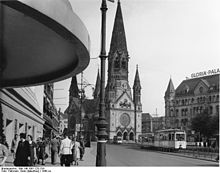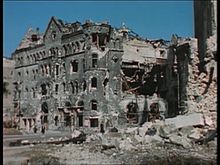First Romanesque House (Berlin)

The Romanisches Haus was a building on the west side of what was then Auguste-Viktoria-Platz in what is now the Berlin district of Charlottenburg between Kurfürstendamm and Kantstrasse . It had the address Kurfürstendamm 10 / 10a and is sometimes also referred to as the First Romanesque House , because a second building with this name was built opposite in 1901.
history
The first Romanesque house in Berlin was planned by Franz Schwechten at the suggestion of the emperor . Schwechten had already designed the Kaiser Wilhelm Memorial Church, which was inaugurated in 1895, and should also design the surroundings of this church accordingly. The first Romanesque house was built in the years 1893-1896 opposite the main portal of the church; later the Second Romanesque House (also: New Romanesque House ) followed, in which the Romanesque Café was located. For Roman Forum also belonged nor the exhibition halls at the Zoo of Carl Gause and the house Kaisereck .
During the construction of the first Romanesque house, Schwechten stayed about seven meters behind the alignment allowed for the construction in order not to diminish the impression of the church. Together with the elaborate facade decoration made of sandstone with continuous loggias and the interior fittings, which included mosaics, marble columns and chimneys and colorful glass windows, this drove up the price of the building: the construction costs were around 1.6 million marks . Apartments in the Romanisches Haus were rented out at a correspondingly high price.
The house belonged to the landscape painter Julius Bodenstein (1847–1932) from 1894 to 1910 . After the sale it was rebuilt: Schwechten planned a Romanesque hotel on the neighboring property in Kantstrasse and the ground floor of the Romanesque house was converted into the “Regina-Palast” restaurant. The undeveloped building site between the alignment line and the house became a pub garden for the period until 1928, when it fell victim to a road widening.
Another renovation took place in 1924 and 1925: The Regina Palace was replaced by Café Trumpf . This café was taken over by Haus Vaterland GmbH in 1931 and later handed over to Kempinski . The Italian writer Giuseppe Tomasi di Lampedusa wrote a detailed description of the café in 1930. It says that Café Trumpf was "as big as the roof of the Palermer train station", but was cleverly subdivided by stairs, mezzanines, etc. According to Tomasi di Lampedusa, the lower parts of the walls were clad in green marble , the upper parts adorned with wax paintings in lighter, gold-sequined green, and the ceiling golden. He also mentions an arcade made of green wooden columns, a dance floor and a glass wall through which one could see “the Kurfürstendamm, the myriad lights, the infernal traffic and the indescribable rain”. According to Tomasi di Lampedusa's description, a 15-piece orchestra played in Café Trumpf . Although he saw the café as a "very common respectful and banal coffee house", Tomasi di Lampedusa also reported on "too smoothly shaved youngsters who sit languidly at the corner tables until an old, fat man with a flushed face and bulging eyes makes up his mind" . During the time of National Socialism , Café Trumpf was one of the establishments in which the Jewish “Greifer” couple Stella Goldschlag and Rolf Rogoff tracked down Jews on behalf of the Gestapo .
During the renovation, the Gloria-Palast film theater was set up on the 1st and 2nd floors . The company J. C. Pfaff, which produced furniture and interior art, had previously used these floors. The cinema held about 1200 viewers and was luxuriously equipped. It was inaugurated in 1926 and quickly became a cinema for world premieres. Among other things, The Blue Angel was shown here for the first time in 1930 .
During the Second World War , the Romanesque House was badly damaged by bombs; later the remains were removed. In the years 1957–1960 (planning and construction time) a wing of the Schimmelpfeng house was built at this point .
Roland fountain

In 1900 , a fountain was set up in the front garden of the Romanisches Haus within the wrought-iron enclosure , which was created according to Schwechen's design for the Berlin trade exhibition of 1896. It consisted of a large fountain bowl, in the middle of which a pedestal surrounded by four lions carried three more bowls one above the other. This structure was crowned by a Roland statue. This fountain was dismantled in 1928 when the front garden of the old Romanesque house fell victim to the road widening. The Roland fountain was sold to the city of Riesenburg (since 1945 Prabuty ) in West Prussia and is practically the only remnant of the old Romanesque house that has been preserved.
Web links
Individual evidence
- ^ Romanesque forum in the online lexicon of the Charlottenburg-Wilmersdorf district of Berlin.
- ↑ Romanesque houses in the online dictionary of the Charlottenburg-Wilmersdorf district of Berlin.
- ↑ Jochen Kleining, M. Kempinski & Co. The "Aryanization" of a traditional Berlin company , Diplomica-Verlag 2008, ISBN 978-3-8366-6194-2 , p. 44
- ^ Giuseppe Tomasi di Lampedusa, A writer on the move. On the move in the metropolises of Europe , Munich / Zurich 2009, ISBN 978-3-492-26368-9 , p. 161.
- ^ Giuseppe Tomasi di Lampedusa, A writer on the move. On the move in the metropolises of Europe , Munich / Zurich 2009, ISBN 978-3-492-26368-9 , p. 162
- ↑ Article “Otherwise you will come to Auschwitz” Stella - a Jewish woman hunting Jews for the Gestapo in the Berlin underground . In: Der Spiegel , October 26, 1992
- ↑ site Aktiensammler.
- ↑ Gloriapalast in the online dictionary of the Charlottenburg-Wilmersdorf district of Berlin.
- ↑ A forgotten fountain at the Kaiser Wilhelm Memorial Church.
Coordinates: 52 ° 30 ′ 17.5 ″ N , 13 ° 20 ′ 1.1 ″ E

